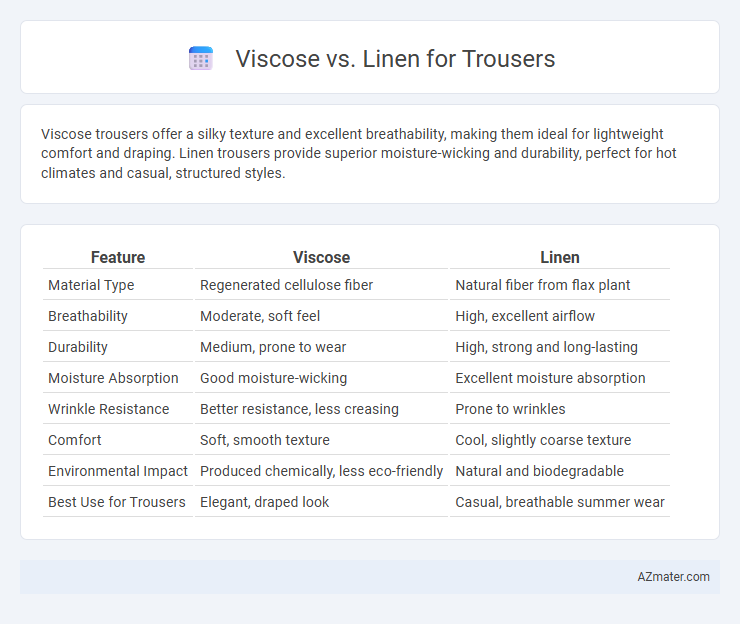Viscose trousers offer a silky texture and excellent breathability, making them ideal for lightweight comfort and draping. Linen trousers provide superior moisture-wicking and durability, perfect for hot climates and casual, structured styles.
Table of Comparison
| Feature | Viscose | Linen |
|---|---|---|
| Material Type | Regenerated cellulose fiber | Natural fiber from flax plant |
| Breathability | Moderate, soft feel | High, excellent airflow |
| Durability | Medium, prone to wear | High, strong and long-lasting |
| Moisture Absorption | Good moisture-wicking | Excellent moisture absorption |
| Wrinkle Resistance | Better resistance, less creasing | Prone to wrinkles |
| Comfort | Soft, smooth texture | Cool, slightly coarse texture |
| Environmental Impact | Produced chemically, less eco-friendly | Natural and biodegradable |
| Best Use for Trousers | Elegant, draped look | Casual, breathable summer wear |
Introduction to Viscose and Linen Fabrics
Viscose is a semi-synthetic fiber made from cellulose derived from wood pulp, known for its silky texture and excellent drape, making it a popular choice for lightweight trousers. Linen, a natural fiber obtained from flax plants, offers superior breathability and moisture-wicking properties, ideal for trousers in warm climates. Both fabrics provide comfort and style, but viscose emphasizes softness and fluidity, while linen stands out for durability and a distinctive textured appearance.
Composition and Origin: Viscose vs Linen
Viscose is a semi-synthetic fiber derived from wood pulp, primarily sourced from beech, pine, and eucalyptus trees, offering a smooth texture with excellent drape and breathability. Linen, made from the flax plant, is a natural fiber known for its strength, durability, and moisture-wicking properties, often cultivated in Europe and parts of Asia. Trouser fabrics made from viscose provide softness and fluidity, while linen trousers deliver a crisp, textured feel with enhanced cooling effects in warm climates.
Breathability and Comfort Comparison
Viscose trousers offer excellent breathability due to their semi-synthetic fiber structure that allows air circulation, while linen provides superior natural breathability and moisture-wicking properties thanks to its flax fibers, making it ideal for hot weather. In terms of comfort, viscose feels soft and smooth against the skin with a silky texture, whereas linen is lightweight but can feel rougher initially and tends to wrinkle easily, affecting long-term wear comfort. Both fabrics excel in breathability, but linen outperforms viscose in moisture absorption, making it a preferred choice for maximum comfort in warm climates.
Durability and Longevity
Linen trousers offer superior durability and longevity due to their natural fibers, which are strong and resistant to wear and tear, making them ideal for long-term use. Viscose trousers, while soft and breathable, tend to have lower durability because the semi-synthetic fibers are prone to weakening and pilling over time. Choosing linen ensures a more resilient fabric that maintains its integrity and appearance after repeated washes and extended wear.
Moisture-Wicking and Absorbency
Viscose trousers offer excellent moisture-wicking properties due to their semi-synthetic cellulose fibers, which effectively draw sweat away from the skin, keeping you dry and comfortable. Linen, derived from the flax plant, excels in absorbency with a natural ability to soak up moisture quickly, making it ideal for hot, humid climates. While linen tends to retain moisture longer leading to a clammy feel, viscose dries faster, providing superior breathability for active wear.
Maintenance and Care Requirements
Viscose trousers require gentle washing, preferably by hand or on a delicate machine cycle, and should be air-dried to prevent shrinking and fabric damage, while linen trousers are more durable, can endure regular machine washing, and require less delicate handling despite their tendency to wrinkle easily. Both fabrics benefit from ironing at medium heat to maintain a smooth appearance, but viscose demands careful handling to avoid weakening fibers, whereas linen can withstand higher temperatures during ironing. Proper storage in a cool, dry place minimizes fabric deterioration for viscose, whereas linen's natural breathability reduces the risk of odor and mildew even with less stringent storage conditions.
Environmental Impact and Sustainability
Viscose, derived from wood pulp, often involves intensive chemical processing and high water usage, raising concerns about deforestation and pollution, whereas linen, made from flax plants, is a more sustainable choice due to its low water needs and biodegradable nature. Linen cultivation generally requires fewer pesticides and fertilizers compared to the raw materials for viscose, reducing harmful environmental effects. Choosing linen trousers promotes eco-friendly fashion by minimizing resource consumption and supporting biodegradable textile waste management.
Style and Aesthetic Appeal
Viscose trousers offer a smooth, silky texture that drapes elegantly, ideal for a polished and sophisticated look, while linen provides a crisp, natural weave that gives a relaxed, breathable aesthetic perfect for casual or summer styles. Viscose's vibrant color retention enhances its sleek appearance, contrasting with linen's matte, slightly textured finish that emphasizes organic charm. Choosing between viscose and linen depends on whether the desired style leans toward refined elegance or effortless, natural coolness.
Price Differences and Value
Viscose trousers generally offer a lower price point compared to linen due to cheaper production costs and synthetic fibers used in viscose fabric. Linen, with its natural fibers and breathable qualities, commands a higher price reflecting durability, comfort, and premium wear over time. The value of linen lies in longevity and moisture-wicking properties, while viscose provides affordable softness and drape ideal for budget-conscious buyers.
Choosing the Best Fabric for Your Trousers
Viscose offers a smooth, lightweight texture with excellent drape and breathability, making it ideal for trousers in warm climates, while linen provides superior durability, moisture-wicking properties, and a natural, crisp look perfect for casual and formal wear. When choosing the best fabric for your trousers, consider the occasion, climate, and maintenance, as viscose requires gentle care to avoid wrinkles, whereas linen is highly breathable but prone to creasing. Both fabrics offer comfort and style benefits, but linen is optimal for an eco-conscious, breathable choice, and viscose suits those seeking a softer feel with a polished finish.

Infographic: Viscose vs Linen for Trouser
 azmater.com
azmater.com